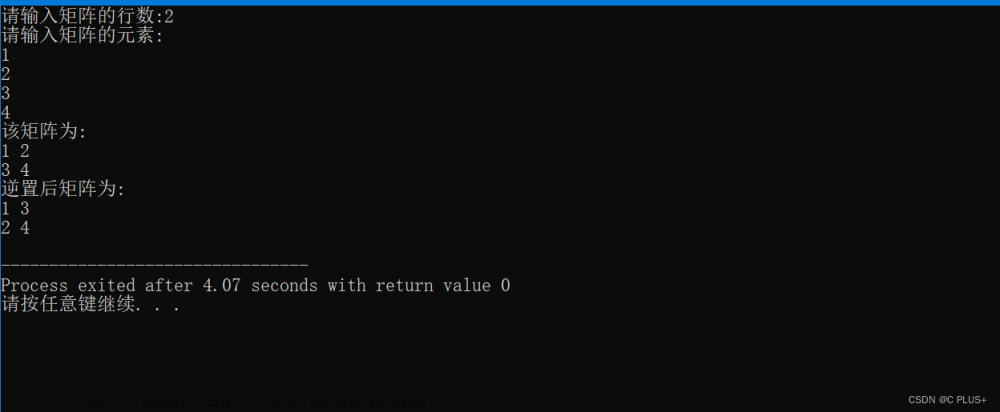- 伴随矩阵和代数余子式法
- 高斯消元法
- LU分解
前言: 本文讲述伴随矩阵求逆,其余方法有时间会加以整理。
参考:
代码实现矩阵求逆的三种方式
矩阵的行列式文章来源:https://www.toymoban.com/news/detail-717735.html
1. 伴随矩阵和代数余子式法
1.1 原理

 文章来源地址https://www.toymoban.com/news/detail-717735.html
文章来源地址https://www.toymoban.com/news/detail-717735.html
1.2 代码
#include <stdio.h>
#include <math.h>
typedef unsigned char uint8;
//全局变量定义
uint8 MatrixSize=4;
double AdjMatrix[4][4] = { 0 };
double detA4 = 0;
//函数声明
double GetdetA3(double matrix[3][3]);
void Adj_matrix4(double* matrix);
int main()
{
printf("Hello!");
double matrixtest[4][4] = {{6,5,-9,6},{2,0,-4,8},{-1,4,2,2},{2,-10,0,-10}};
double det = 0;
double InvMtrx[4][4] = { 0 };
Adj_matrix4(&matrixtest[0][0]);
if (detA4 == 0) return;
else {
for (uint8 i = 0; i < 4; i++) {
for (uint8 j = 0; j < 4; j++) {
InvMtrx[i][j] = AdjMatrix[i][j] / detA4;
}
}
}
return 0;
}
//MatrixSize; MatrixSize = sizeof matrix / sizeof matrix[0];
double GetdetA3(double matrix[3][3])
{
double detA3 = 0;
detA3 = matrix[0][0] * matrix[1][1] * matrix[2][2] + matrix[0][1] * matrix[1][2] * matrix[2][0] + matrix[0][2] * matrix[1][0] * matrix[2][1]
- matrix[0][2] * matrix[1][1] * matrix[2][0] - matrix[0][1] * matrix[1][0] * matrix[2][2] - matrix[0][0] * matrix[1][2] * matrix[2][1];
return detA3;
}
//四阶矩阵的伴随矩阵
void Adj_matrix4(double *matrix){
double tmp[3][3] = { {0} ,{0} ,{0} };
for(uint8 row = 0; row < 4; row++){
for (uint8 colm = 0; colm < 4; colm++){
//求第row、colm余子式矩阵
uint8 k=0, p = 0;
for (uint8 i = 0; i < 3;i++ ) {
if (i == colm) p++;
for (uint8 j = 0;j < 3; j++ ) {
if (j == row) k++;
tmp[i][j] = *(matrix +k+4*p+j);
}
k = 0;
p++;
}
//求余子式矩阵行列式
double C_0colm = GetdetA3(tmp);
//求出相应的代数余子式
AdjMatrix[row][colm] = pow(-1, row + colm) * C_0colm;
if (row==0) detA4 = detA4 + (* (matrix + row + colm * 4))* AdjMatrix[row][colm];
}
}
}
到了这里,关于C语言实现矩阵求逆(四阶)的文章就介绍完了。如果您还想了解更多内容,请在右上角搜索TOY模板网以前的文章或继续浏览下面的相关文章,希望大家以后多多支持TOY模板网!











